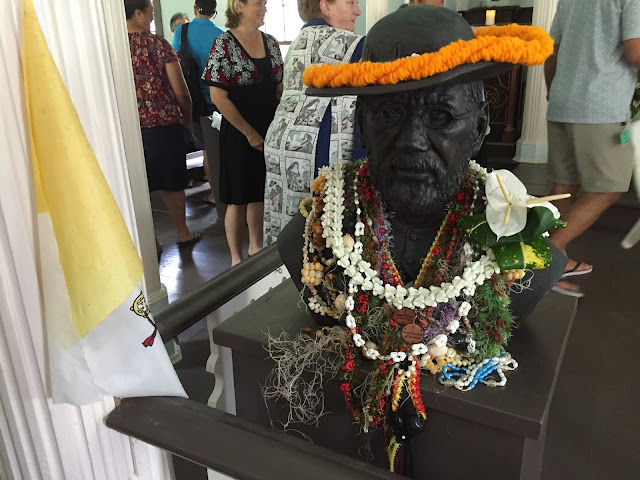Leprosy is an ancient disease that pertains to most all regions of the world at some point in time. In the Western context, it may be a disease of the far or recent past, while in some countries in Asia and Africa, the disease has still a lot of currency. Nowadays, the world seems to be starkly divided between parts of the world where it is mostly forgotten and a shame if it could not be forgotten. Away from the daily experience, leprosy becomes metaphorical, to refer to something repugnant. The dominant medical discourse is one that pertains to its final extermination, its disappearance, and to relegating the disease to the past. In this blog entry, I wish to evaluate some of the actors that pertain to preserving the history and legacy of leprosy, which leads me in the direction of colonial governance, religion, and especially the arts. Throughout the world, the recent history over the past 150 years can hardly be seen outside the colonial context, its governmental policies of segregation, the response of religions, and the arts. The modern context, according to Michel Foucault, established a relation between knowledge and the legitimation to remove people outside the society. Perhaps more than anything else, it is the arts that have an enduring impact on the way of remembering leprosy, and that capture most the weight of history and the enduring impact of its heritage. While medicine attempts to the disappearance, the arts continue to capture and challenge its existence.
Throughout the world, segregation practices were implemented in the 19 th century. They were quite different from the practices of medieval times that required that people with leprosy announced their presence with a clapper or a bell, before leper houses were established. One chronicler in the 13th century calculated the existence of some 12000 leper houses throughout Europe, for care and quarantine, and these were organized like convents and monasteries (Ashworth 2010). The segregation practices of the 19 th century included the exile of people with leprosy to islands or otherwise isolated areas, in the context of nations states and colonization. Famous examples are Kalaupapa, Sorok Island, Robben Island, and otherwise isolated areas such as the remote villages in China’s southwest, or some remote valleys, such as the Hemel en Aarde Vallei in South Africa’s Western Cape Province, or Anandwan in Maharashtra, India, or Yonda Leprosy Settlement in the Democratic Republic Congo. Such places were often places of heroic collaboration between government and Christian churches, but in some cases like Anandwan, also the ground of non-religious heroism. Its heroism however is always one of service.
 |
| Sculpture of Father Damien at St.
Philomena Church, Kalaupapa, Molokai. Photo credit: Patrick Devlieger |
The photographic and filmic work that pertains to leprosy settlement requires a discussion of its own. However, I wish to make an exception for ‘The House is Black’ of Forough Farrokhzad (1962), a film set in the Bababaghi Leprosarium in Iran, which is an example of a cinema vérité documentary, in which images are thematically arranged with the voice-over poetry of the maker, asking questions of the origins, and meaning of suffering in other people, and the similarities between them and ourselves, thus extending a dialogue between maker and reality, into a dialogue with the audience (Assizi and Moslim 2011).
Where artists work with the material of leprosy and convey facts and ideas for being able to remember and thus create a future, there is perhaps still another way in which the heritage of leprosy is scientifically being created, through what remains materially present, and to preserve and renew the natural landscape (which is also cultural). I wish to give two examples. The first one is a heritage garden at Sorok Island Leprosy settlement. It was created by patients with leprosy, perhaps even through their forced labor, and it holds heritage trees, religious and secular memorials, that allow for pilgrimage, walking, and reflecting. The other is Kalaupapa’s archaeological and natural conservation programs, pertaining to document the changing landscape, and a program of controlling invasive animal and plants, as well as the conservation and reintroduction of heritage trees and native plants. Archeological research at Kalaupapa makes it possible to understand how the changing landscape is testimony of people’s functional occupations but also their solutions, challenges, and suffering (Flexner 2010). Perhaps this is the real aim of heritage: to create a dialogue with the past, to be affected by it, and to create spaces for remembering. Heritage is education with the purpose of learning as well as being affected. It seems that heritage of leprosy is already created by all the participants or witnesses of the practices, but heritage becomes eventually a way of surpassing the practices of the past or the present.
To conclude, leprosy’s ancient and scientifically obscure nature, as well as its devastating impact, its ground for suffering and segregation, deserves attention from scholars and educators, to join the artists that have already opened the way to greater understanding and empathy.
References cited:
Aschworth, Elizabeth (2010). Leprosy in the middle ages. Available at: https://elizabethashworth.com/2010/07/22/leprosy-in-the-middle- ages/. Accessed on June 13 th, 2017.
Azizi, Mohammad Hossein and Moslem Bahadori (2011). History of Leprosy in Iran during the 19th and 20th Centuries. Archives of Iranian Medicine, 14 (6): 425-430.
Clifford, Edward (1889). Father Damien; A Journey from Cashmere to his Home in Hawaii, London: Macmillan.
Flexner, James (2010). Archaeology of the Recent Past at Kalawao: Landscape, Place, and Power in a Hawaiian Hansen's Disease Settlement. PhD Dissertation. Berkeley: University of California.
Hermann, Maurer (2010). The wife of Michel Lechat, a well-known artist is giving, in what follows, an impression of the Leprosy settlement. Available at http://www.ae-info.org/ae/Member/Lechat_Michel/Highlight/Pictures_by_Edith_Dasnoy. Accessed on June 9 th, 2017.
Skinsnes Law, Anwei (2012). Kalaupapa: A Collective Memory. Honolulu: University of Hawaii Press.
Woods, Fred (2017). Reflections of Kalaupapa. Y Mountain Press.
Recommended Citation:
Patrick Devlieger (2017): Leprosy, Heritage, and Art: Histories of Exile in a World Perspective. In: Public Disability History 2 (2017) 10.



